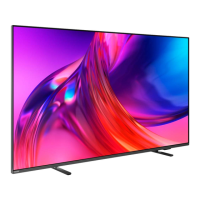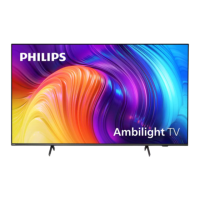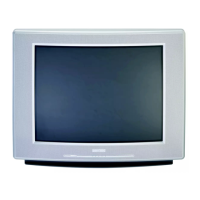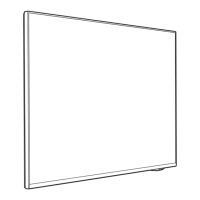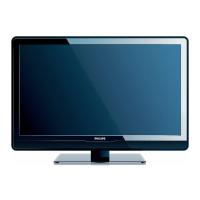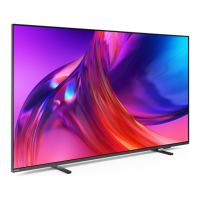
Do you have a question about the Philips 8508 Series and is the answer not in the manual?
| Audio Technology | Dolby Atmos |
|---|---|
| Smart TV Platform | Google TV |
| Ethernet | Yes |
| Screen Size | 65 inches |
| Resolution | 4K Ultra HD (3840 x 2160) |
| Display Technology | LED |
| HDR Support | HDR10+, HLG |
| HDMI Ports | 4 |
| Speaker Type | 2.0 Channel |
| Voice Control | Google Assistant |
Provides an overview of the Home screen and its benefits for Google TV.
Explains the Dashboard panel and how to access and adjust TV settings.
Differentiates between Google TV and Basic Mode features and requirements.
Provides step-by-step instructions to open and navigate the Home screen.
Advises reading safety instructions before using the TV.
Covers instructions for mounting the TV stand and wall mounting.
Offers guidance on optimal TV placement for viewing and Ambilight.
Details how to connect and handle the power cable safely.
Explains how to connect the antenna cable for TV signals.
Describes how to connect the satellite F-type connector.
Details the functions of different keys on the remote control (Type 1 and Type 2).
Guides on how to pair the remote control with the TV using Bluetooth and IR.
Explains how to use voice search after pairing the remote.
Provides information about the TV's infrared sensor for remote control.
Instructions for replacing batteries and cleaning the remote control.
Explains how to switch the TV on, put it in standby, and reboot.
Describes basic TV operations using the TV's joystick key when the remote is unavailable.
Details the process of installing satellite channels, including Unicable systems.
Guides on updating channels via antenna/cable installation.
Explains how to copy and upload channel lists between TVs.
Refers to Help for information on channel installation.
Describes how channel lists are organized and how to navigate them.
Explains how to sort and filter channel lists.
Covers tuning, switching, and locking channels.
Explains how to create and manage favourite channel lists.
Explains how to open and close Text/Teletext pages.
Introduces Interactive TV features like HbbTV and guides usage.
Explains the TV Guide and what information it displays.
Covers opening, tuning, viewing details, and changing days in the TV Guide.
Provides a connectivity guide and explains device recognition.
Details connecting a Home Theatre System via HDMI ARC/eARC.
Explains the optical audio connection for high-quality sound.
Explains CI+ for watching premium HD programs and its requirements.
Guides on inserting the smart card into the CAM module.
Describes connecting smartphones/tablets via the Philips TV Remote App.
Instructions for connecting a Blu-ray disc player via HDMI.
Details how to connect headphones and adjust volume.
Guides on connecting a game console via HDMI for best quality.
Explains how to connect a USB keyboard for text input.
Describes viewing photos/music/videos from USB storage.
Guides on connecting a digital photo camera via USB.
Instructions for connecting a camcorder via HDMI.
Explains connecting a computer to use the TV as a PC monitor.
Covers connecting the TV to a home network and the Internet.
Details settings for Wi-Fi, Chromecast, and Digital Media Renderer.
Explains how to sign in with a Google Account for full TV capabilities.
Guides on starting and using the TV's built-in web browser.
Explains how to switch between connected devices and TV tuners.
Describes accessing TV functions and settings quickly via menus.
Covers picture settings, styles, and adjustments for optimal viewing.
Details picture format adjustments and Ultra Motion Clarity settings.
Explains selecting preset sound styles and optimizing sound based on placement.
Explains audio output options, including TV speakers and HDMI CEC.
Guides on turning Ambilight on/off and selecting Ambilight styles.
Explains using Ambilight, music, and weather for a wake-up experience.
Describes the Aurora app for enhancing ambiance with Ambilight.
Introduces apps and how to install them from Google Play Store.
Details downloading and installing apps from the Google Play Store.
Guides on starting and stopping applications on the TV.
Explains how to stop apps, clear cache, and uninstall unused apps.
Covers accessibility features like high contrast text and text-to-speech.
Details system software updates from the Internet or USB.
Explains how to reinstall the TV or reset settings to factory defaults.
Covers settings for date, time, time zone, and display language.
Details USB keyboard setup and internal storage usage checks.
Guides on configuring screen saver and power management features.
Explains how to cast content from mobile devices using Google Cast.
Covers enabling or disabling system sounds.
Details setting up a child lock code for channels and programs.
Explains settings for home or shop display modes and promotional content.
Guides on how to restart the TV to improve performance.
Covers pairing and managing Bluetooth devices.
Details pairing the remote control and checking its info.
Explains how to check for and update remote control software.
Guides on viewing media from a computer or NAS via network.
Explains how to add and view favourite media files and folders.
Covers viewing most popular and last played media files.
Guides on viewing media files directly from a USB drive.
Details how to open video folders and play videos from USB.
Guides on opening photo folders and viewing photos from USB.
Explains how to open music folders and play music from USB.
Details using the Philips TV Remote App for control and setup.
Outlines requirements for playing games from Google Play or consoles.
Covers connecting wireless gamepads for gaming.
Guides on connecting consoles/computers and starting games.
Explains the gaming control bar for in-game settings and info.
Information on using the Netflix app and its spatial audio feature.
Provides an overview of Alexa voice control and its requirements.
Guides on setting up and using Alexa voice control on the TV.
Details environmental information, energy labels, and disposal.
Lists power specifications and saving features.
Specifies the TV's operating system (Android OS).
Covers TV tuner capabilities, signal support, and input ranges.
Lists diagonal screen sizes and display resolution.
Details supported computer and video resolutions and refresh rates.
Lists all available TV connection ports and interfaces.
Lists sound specifications like output power and audio technologies.
Details supported multimedia connections, file systems, and codecs.
Guides on registering the TV for support and benefits.
Explains how to access and use the TV's built-in help system.
Covers running diagnostic tests for troubleshooting TV issues.
Provides solutions for common TV issues like no picture or sound.
Directs users to online support resources for troubleshooting.
Provides contact information for customer support and repair services.
Details important safety instructions to prevent injury or fire.
Offers guidance on cleaning and maintaining the TV screen safely.
Outlines the terms of use, warranty, and pixel/backlight characteristics.
Guides on accessing Smart TV terms of use, privacy policy, and settings.
Lists trademarks related to Google TV.
Mentions HDMI terms and logos.
Notes patents related to HEVC technology.
Mentions AMD FreeSync Premium technology.
Lists Dolby trademarks and copyright information.
Notes DTS patents and trademarks.
Lists DTS Play-Fi trademarks and patents.
Mentions Wi-Fi CERTIFIED logo trademark.
Mentions Kensington trademarks.
States that other trademarks are property of their owners.
States TP Vision's non-responsibility for changes or termination of third-party services/software.
